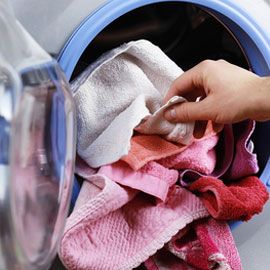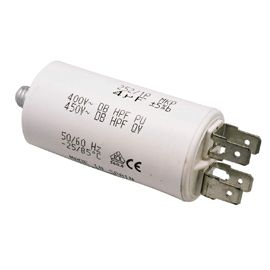Your Washing Machine’s Drum Is Not Spinning

There are various possible reasons why your washing machine's drum will no longer turn, such as a broken drive belt or a defective electronic component for example. All these various aspects must therefore be checked when trying to find the source of the issue.
THE POSSIBLE CAUSES FOR THIS FAULT:
-
The appliance is not plugged in to the electricity source
-
There is too much washing in the machine
-
The door security lock is defective
-
The door handle or catch is not working properly
-
The drive belt has come off or failed completely
-
The solenoid valve is defective
-
The heating element is faulty
-
The thermal cut-out is defective
-
The thermostat is faulty
-
The carbon brushes need replacing
-
The motor capacitor is not working properly
-
The motor is out of order
-
The circuit board is faulty
WARNING
Before you do anything to your appliance, make sure you disconnect it from the power supply.
There is a risk of electric shock.
Wear suitable protective gloves if you need to dismantle anything. There is a risk of getting cut or injured
The appliance is not plugged in to the electricity source
 Though it might seem a silly thing to have to check, you should first make sure the appliance is actually being supplied with electricity. Does the appliance come on as normal? Check that the plug is properly plugged in, and test the socket to see if it's working okay (by plugging another appliance into it for example). You can also use this is an opportunity to leave the washing machine unplugged for around 20 minutes, which can sometimes be enough to resolve the problem.
Though it might seem a silly thing to have to check, you should first make sure the appliance is actually being supplied with electricity. Does the appliance come on as normal? Check that the plug is properly plugged in, and test the socket to see if it's working okay (by plugging another appliance into it for example). You can also use this is an opportunity to leave the washing machine unplugged for around 20 minutes, which can sometimes be enough to resolve the problem.
There is too much washing in the machine
 The motor may not be powerful enough to handle loads heavier than the manufacturer intended. Before proceeding to take your washing machine apart, first check the drum is not overloaded, and always remember not to exceed the maximum washing load weight stipulated by your appliance's manufacturer.
The motor may not be powerful enough to handle loads heavier than the manufacturer intended. Before proceeding to take your washing machine apart, first check the drum is not overloaded, and always remember not to exceed the maximum washing load weight stipulated by your appliance's manufacturer.
The door security lock is defective
 Your washing machine can only operate properly with the door completely and fully closed. If the door security lock is defective, the washing machine will refuse to start the wash programme. Depending on the model, your washing machine may have an indicator light that lets you know the door is not closed properly. Test the door lock using a multimeter, and replace it if it's broken.
Your washing machine can only operate properly with the door completely and fully closed. If the door security lock is defective, the washing machine will refuse to start the wash programme. Depending on the model, your washing machine may have an indicator light that lets you know the door is not closed properly. Test the door lock using a multimeter, and replace it if it's broken.
The door handle or catch is not working properly
 Your washing machine's door handle is equipped with a catch that enables the door to close securely. If it does not engage properly with the latch, it will fail to operate properly and the drum will be prevented from turning. Check the condition of the door catch and replace it if necessary.
Your washing machine's door handle is equipped with a catch that enables the door to close securely. If it does not engage properly with the latch, it will fail to operate properly and the drum will be prevented from turning. Check the condition of the door catch and replace it if necessary.
The belt that drives the drum has come off or failed completely
 The drive belt transfers the rotational power of the motor to the drum. If it comes off or fails completely, it can prevent the washing machine from turning properly. If you can hear the motor operating but the drum remains stationary, this means the belt has either come off or snapped. To find out if this is the case, simply remove one of the panels from your machine and check the condition of the drive belt. If it's still in a useable condition, simply put it back in place. If it's misshapen or damaged in any way, it's best to replace it.
The drive belt transfers the rotational power of the motor to the drum. If it comes off or fails completely, it can prevent the washing machine from turning properly. If you can hear the motor operating but the drum remains stationary, this means the belt has either come off or snapped. To find out if this is the case, simply remove one of the panels from your machine and check the condition of the drive belt. If it's still in a useable condition, simply put it back in place. If it's misshapen or damaged in any way, it's best to replace it.
The solenoid valve is defective
 The solenoid is actually an electric valve that controls the flow of water to your washing machine. If one of the coils on the solenoid is defective, the appliance may not be able to take in water and begin operating, or it could fill with water then wait for the second valve to open; should this second valve then in fact fail to open, the appliance will remain stuck. You can check whether the solenoid valve is working properly using a multimeter in ohmmeter mode. Disconnect all the connectors and place the meter's two probes on the solenoid's terminals. You should get a reading of around 4 kilo ohms.
The solenoid is actually an electric valve that controls the flow of water to your washing machine. If one of the coils on the solenoid is defective, the appliance may not be able to take in water and begin operating, or it could fill with water then wait for the second valve to open; should this second valve then in fact fail to open, the appliance will remain stuck. You can check whether the solenoid valve is working properly using a multimeter in ohmmeter mode. Disconnect all the connectors and place the meter's two probes on the solenoid's terminals. You should get a reading of around 4 kilo ohms.
The heating element is faulty
 The heating element heats the water inside your washing machine. On some machines, the motor will not start if the required temperature has not been reached. Check the condition of the heating element using a multimeter in ohmmeter mode. It should give a reading of around 30 ohms, depending on the model. You could also try running a cold wash programme (0°C). If this works okay, the heating element may be the source of the problem, in which case it will need replacing.
The heating element heats the water inside your washing machine. On some machines, the motor will not start if the required temperature has not been reached. Check the condition of the heating element using a multimeter in ohmmeter mode. It should give a reading of around 30 ohms, depending on the model. You could also try running a cold wash programme (0°C). If this works okay, the heating element may be the source of the problem, in which case it will need replacing.
The thermal cut-out is defective
 Thermal cut-outs are mainly found on older-generation appliances They work by cutting the power to the heating element to prevent the machine overheating. If the thermal cut-out is faulty, the motor will no longer operate: it will wait forever for the heating element to reach the right temperature. You can check the thermal cut-out is working properly using a multimeter.
Thermal cut-outs are mainly found on older-generation appliances They work by cutting the power to the heating element to prevent the machine overheating. If the thermal cut-out is faulty, the motor will no longer operate: it will wait forever for the heating element to reach the right temperature. You can check the thermal cut-out is working properly using a multimeter.
The thermostat is faulty
 Older-generation washing machines are equipped with an adjustable thermostat that enables you to manually select from a range of wash temperatures between 0°C and 90°C. If this thermostat is defective, the washing machine will not heat up and will not be able to reach the required temperature. The drum will therefore not turn. Test the thermostat using a multimeter. If you get no reading, the thermostat may be the cause of the problem.
Older-generation washing machines are equipped with an adjustable thermostat that enables you to manually select from a range of wash temperatures between 0°C and 90°C. If this thermostat is defective, the washing machine will not heat up and will not be able to reach the required temperature. The drum will therefore not turn. Test the thermostat using a multimeter. If you get no reading, the thermostat may be the cause of the problem.
The carbon brushes need replacing
 The motor brushes (or carbon brushes) transfer electricity to the moving part of the motor. Over time, the carbon brushes wear out and no longer come into proper contact with the commutator. This prevents the washing machine motor from operating. To find out whether your motor brushes need replacing, tip the appliance up and tap lightly on the motor shaft with a wooden mallet. Next restart the wash cycle; if the appliance now operates, the brushes need to be changed. The brushes must be over 1 cm in length to ensure correct operation.
The motor brushes (or carbon brushes) transfer electricity to the moving part of the motor. Over time, the carbon brushes wear out and no longer come into proper contact with the commutator. This prevents the washing machine motor from operating. To find out whether your motor brushes need replacing, tip the appliance up and tap lightly on the motor shaft with a wooden mallet. Next restart the wash cycle; if the appliance now operates, the brushes need to be changed. The brushes must be over 1 cm in length to ensure correct operation.
The motor capacitor is not working properly
 The capacitor serves to both start the motor and maintain its torque. If the capacitor is defective, the motor will attempt to start but will not succeed. To check the condition of the capacitor, remove the washing machine access panels and begin a wash cycle. When you hear the motor attempting to start, try manually turning the drum pulley to get the motor moving. If the motor then starts operating, it's likely the capacitor is faulty. Take the usual safety precautions when carrying out this procedure, and protect your hands with gloves: you could otherwise get injured when the motor begins operating!
The capacitor serves to both start the motor and maintain its torque. If the capacitor is defective, the motor will attempt to start but will not succeed. To check the condition of the capacitor, remove the washing machine access panels and begin a wash cycle. When you hear the motor attempting to start, try manually turning the drum pulley to get the motor moving. If the motor then starts operating, it's likely the capacitor is faulty. Take the usual safety precautions when carrying out this procedure, and protect your hands with gloves: you could otherwise get injured when the motor begins operating!
The motor is out of order
 The motor turns the drum via the drive belt and drum pulley. If you cannot hear the motor operating when you put your washing machine on, there's probably an issue with it. To check its condition, open up the machine and make sure all the relevant parts are in good working order, and measure the resistances of the coils to see if they give the correct ohm value readings. Also check that the motor's screw terminal block has not burned out. Washing machine motors are fitted with thermal safety cut-outs that protect them against voltage surges and mechanical overload. If this cut-out refuses to reset, the motor will need to be replaced.
The motor turns the drum via the drive belt and drum pulley. If you cannot hear the motor operating when you put your washing machine on, there's probably an issue with it. To check its condition, open up the machine and make sure all the relevant parts are in good working order, and measure the resistances of the coils to see if they give the correct ohm value readings. Also check that the motor's screw terminal block has not burned out. Washing machine motors are fitted with thermal safety cut-outs that protect them against voltage surges and mechanical overload. If this cut-out refuses to reset, the motor will need to be replaced.
Purchase a washing machine motor
The circuit board is defective
 The electronic control module manages all your washing machine's functions (motor, heating, water, etc.). If everything else has been checked and the cause of the problem has not been found, it may well be the control module that needs replacing. This could be a costly operation, however, so make sure you carefully check everything else before turning your attention to the circuit board.
The electronic control module manages all your washing machine's functions (motor, heating, water, etc.). If everything else has been checked and the cause of the problem has not been found, it may well be the control module that needs replacing. This could be a costly operation, however, so make sure you carefully check everything else before turning your attention to the circuit board.
